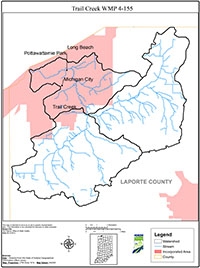Summary
Within the Trail Creek Watershed, there are naturally occurring nonpoint sources of pollution along with man-made point and non-point sources of pollution. In December 2003, the Indiana Department of Environmental Management (IDEM) issued a detailed technical report regarding excessive E. coli levels in Trail Creek entitled “Trail Creek Escherichia coli (E. coli) TMDL (Total Maximum Daily Load) Report.” This report indicated that for point sources of E. coli pollution, such as wastewater treatment plants, the “NPDES permitting and monitoring requirements will provide the necessary reasonable assurance that these sources are not contributing to violations of state E. coli standards.” For nonpoint sources of E. coli pollution, the report concluded that “nonpoint sources will need to be monitored locally for implementation of BMPs (best management practices) or in providing access to watershed grants to assist in reducing nonpoint sources to meet the load allocations (LA) developed under this TMDL.” The preparation of this watershed management plan (WMP) update is the next logical step in achieving cleaner water in northwestern LaPorte County as envisioned by IDEM in 2003.
As the 2003 Trail Creek TMDL report indicates, the total elimination of all pollutant sources within the watershed is not realistic and not economically feasible. However, through the efforts of multiple entities and utilizing a variety of different approaches, it is possible to reduce the pollutant loading to a level which will not adversely affect either human health or water quality. As local citizens, we must rely on the technical expertise of water quality professionals to set maximum levels of pollution or LAs that will not cause long-term harm to human and aquatic health. But as local citizens, we must also educate ourselves with respect to practices that, if implemented, will result in verifiable reduction in levels of pollution in our local watershed.
Trail Creek is a tale of two creeks, heavily influenced by stormwater and watershed land use. The first creek is a rich, vibrant, high quality, cold water habitat full of salmon, steelhead and trout. This creek’s water is clear and flows gently over cobble riffles. The stream banks are stable, and vegetation covers the entire width of the creek. This creek is a source of pride and enjoyment for the community with multiple parks and recreational areas along the creek.
The second creek, the one influenced by stormwater pollutants during rain events, is murky and muddy carrying untold pollutants and trash. Sediment carried by the creek fills the riffles and high-water flows cause streambank erosion. Pollutant loads associated with stormwater runoff, including bacterial contamination, are excessive and warnings are issued to avoid touching the creek’s water and to avoid entering Lake Michigan as a result.
With all of the complexities and time demands of modern-day life, it was necessary to engage in watershed management to educate all citizens that every drop of water is a precious resource. This Trail Creek WMP provides comprehensive guidance for voluntary efforts that will result in the latter: a cleaner source of water.

